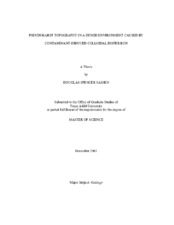| dc.description.abstract | Over fifty small sinkholes (~1 meter in depth and width) were found in conjunction with structural damage to homes in an area south of Cleveland, TX. The local geology lacks carbonate and evaporite deposits associated with normal sinkhole development through dissolution. The morphology and distribution of sinkholes, and the geologic setting of the site are consistent with piping erosion. However, the site lacked the significant hydraulic gradient or exit points for sediment associated with traditional piping erosion. In areas of sinkholes, geophysical measurements of apparent electrical conductivity delineated anomalously high conductivity levels that are interpreted as a brine release from a nearby oil-field waste injection well. The contaminated areas have sodium adsorption ratios (SAR) as high as 19, compared to background levels of 3. Sodium has been shown to cause dispersion of soil colloids, allowing for sediment transport at very low velocities. Thus, subsurface erosion of dispersed sediment could be possible without significant hydraulic gradients. This hypothesis is backed by the observation of the depletion of colloidal particles within the E-horizon of sinkholes. However, there is a lack of precedence of waste brines initiating colloid dispersion. Also, sodium dispersion is not thought to be an important process in piping erosion in humid settings such as this one. Therefore, laboratory experiments on samples from the site area, designed to simulate field conditions, were conducted to measure dispersion verses pH, SAR and electrical conductivity (EC). Analysis of the experimental data with neural networks showed that an increase in SAR did increase dispersion. A dispersion prediction map, constructed with the trained neural network and calibrated geophysical data, showed correlation between sinkhole locations and increased predicted dispersion. This research indicates that a contaminant high in sodium content has caused colloidal dispersion, which may have allowed nontraditional subsurface erosion to occur in an area lacking a significant hydraulic gradient. | en |


